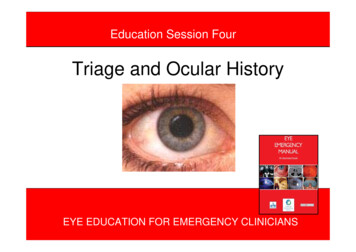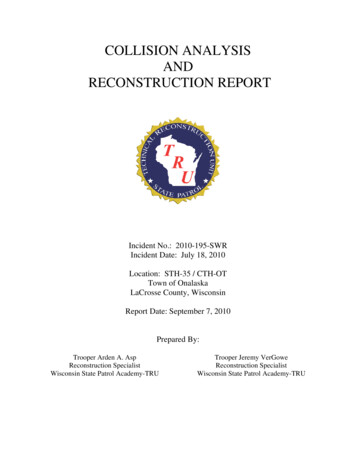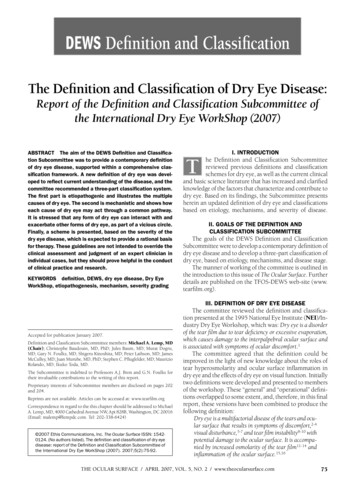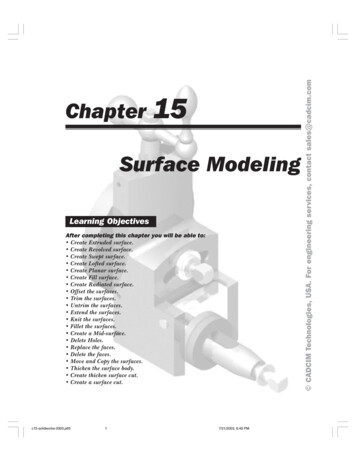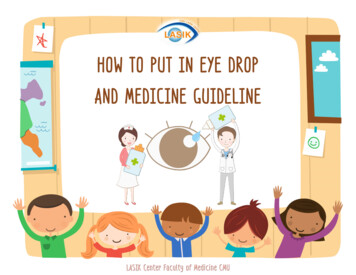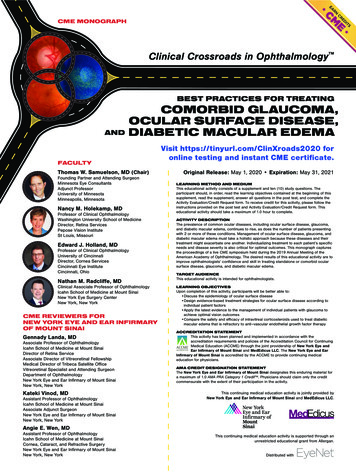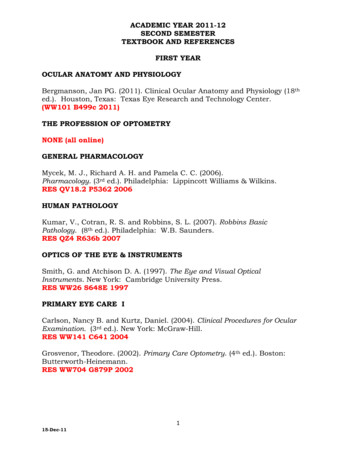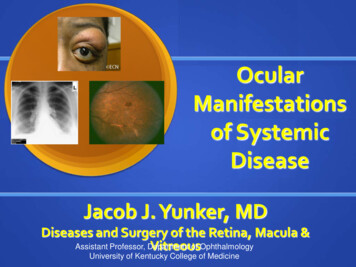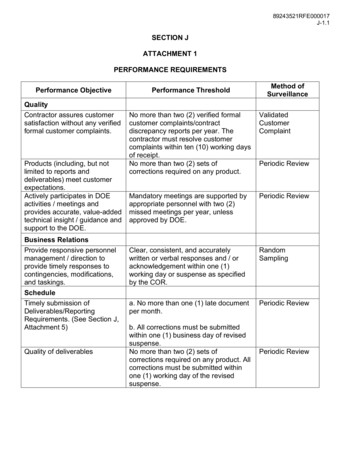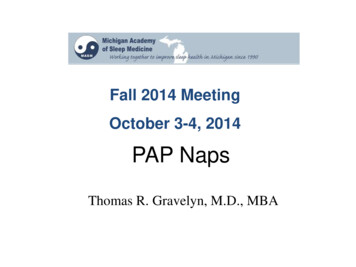
Transcription
Fall 2014 MeetingOctober 3-4, 2014PAP NapsThomas R. Gravelyn, M.D., MBA
Conflict of Interest Disclosures for Speakers1. I do not have any relationships with any entities producing, marketing, re-selling, ordistributing health care goods or services consumed by, or used on, patients, ORX2. I have the following relationships with entities producing, marketing, re-selling, ordistributing health care goods or services consumed by, or used on, patients:Type of Potential ConflictDetails of Potential ConflictGrant/Research SupportConsultantSpeakers’ BureausSunovion, Forest, Boehringer IngelheimFinancial supportOtherX3. The material presented in this lecture has no relationship with any of these potential conflicts, OR4. This talk presents material that is related to one or more of these potential conflicts, and the followingobjective references are provided as support for this lecture:1.2.3.
CPAP
CPAPLuke, I amyour father!One look at this CPAP mask and myreply was no way that's happening!
CPAP CPAP is as much about the mask as it isabout the pressure If the mask leaks, causes sores or pain,moves around at night or is not suitable fora given patient (i.e. mouth venting,claustrophobia, etc.) noncompliance orineffective treatment results
CPAP If you think the DME is going to take care ofthe mask fitting, mask desensitization, assessfor mouth venting and mask leak, let thepatient take a short nap in the store .
The Modern DMESelf Serve
What is a PAP Nap? A Pap Nap is a daytime abbreviated cardiorespiratory sleep study (95807-52) Physiologic exposure to pressurized airflow Mask desensitization Super-duper mask re-fitting with road testing! Not necessary that the patient actually sleeps
PAP Nap Broken Down CPAP DesensitizationAssess anxiety and coping skillsDesensitize the mask on face experienceTrial of BIPAP if difficulty with CPAP Mask re-fittingNasal or full face maskCheck for leak during sleepChin strap or full face maskEmpower the patient with choice
PAP Nap Broken Down CPAP DesensitizationAssess anxiety and coping skillsDesensitize the mask on face experienceTrial of BIPAP if difficulty with CPAP Mask re-fittingNasal or full face maskCheck for leak during sleepChin strap or full face maskEmpower the patient with choice
PAP Nap Daytime appointment ranging from 3-4 hr. Introduction to PAP therapy Barrier assessment Study hook-up (limited to 10 channels) Attempt to nap with masks of choice Post-test follow-up
Indications for a PAP Nap Claustrophobic when trialing CPAP masksduring the baseline polysomnogram Apprehension noted during baseline study Complaints of poor mask fit, mask leak, facialpain, dry mouth Noncompliant or “failing CPAP”
Patient 1 65 year old male Vietnam Veteran.Past medical history: Obesity, HTN, DM, CAD.Occupation: Truck Driver.Polysomnogram: AHI 91, min O2 63%.Symptoms of obstructive sleep apnea: includeexcessive daytime somnolence and frequentnocturia.
Patient 1 “I don’t think I could handle that mask andmachine.” “Whenever something touches my face duringsleep, I wake up thinking someone is holdingtheir hand over my face.” “The pressure might make me wake upthinking someone is trying to choke me.”
Patient 2 58 year old woman, chief executive officer. Past medical history: Chronic insomnia, sleeponset and sleep maintenance; obesity. Otherwisehealthy. Excellent sleep hygiene. Polysomnogram: AHI 62, min O2 81%. Symptoms of obstructive sleep apnea: Patient’sonly subjective complaint is the insomnia.Husband’s history of loud snoring and witnessedpauses in breathing is argued by the patient.
Patient 2 “I don’t need this machine. I’m here fortreatment of my insomnia.” “If you try to make me wear this machine, Iwill never sleep.” “I know I could never sleep with something onmy face.”
PAP Nap Protocol Pre-test instructions Intro. to PAP therapy & barrier assessment PAP Nap Hook-up10 channel including: snore mic, pressure transducer, mask leak channel,resp. effort belt, EKG, oximetry, video, body position, PAP pressure, Post-Test follow-up
Introduction to Pap Therapy Demonstrating the CPAP unit. Education of standard/basic CPAP features– Power on and off– When to put on mask in regard to power on andoff– Ramp feature– Humidity adjustment– Humidification Chamber– Tubing
Barrier Assessment MASK– Leak (Sizing, Facial Structure, Wrinkles, Beard)– Model– Pain/pressure– Rash– Headgear– Claustrophobia– PTSD– Unconscious removal**
Liners and Cushionsa) REMZzz’s cotton mask linersb) Pad –A-Cheekc) Gel Nasal Pads for CPAPd) Mole Skin. The roles of moleskin tape areeasiest for patients to use.e) Duoderm
Barrier Assessment PRESSURE– Pressure sensitivity– Unable to fall asleep due to difficulty breathingwith pressure– Waking up feeling pressure is too great andremoving mask– Utilizing ramp– Aerophagia
Barrier Assessment DRYNESS– Dry nose– Dry mouth Mouth venting Already with FFM and max humidity– Condensation– Insulating sleeve– Heated humidified tubingIf patient is wearing a nasal mask and complains ofdry mouth, oral venting should be the firstconsideration.
Patient 3 74 year old man, retired. Past medical history: Stroke, CAD, Atrialfibrillation, HTN, severe obstructive sleepapnea intolerant to CPAP. Polysomnogram: AHI 80, min O2 58%. Motivated to treat his obstructive sleep apneafor reduced cardiovascular andcerebrovascular risk.
Patient 3 “I can’t tolerate that CPAP.”When you ask why, he cannot pinpoint.Only tried for 2 nights last year.Only ever tried and used one mask -- the FFMthat his tech told him he “needed” at the start ofthe sleep study. Had no contact with the DME or his PCP (whowas managing). Self D/Ced therapy. Never told PCP.
Patient 4 47 year old man.Past medical history: HTN, Depression.Occupation: Sales manager.Polysomnogram: AHI 37, min O2 74%.Symptoms of obstructive sleep apnea: Snorearousals, gasping arousals, multiple nocturnalarousals, non-refreshing sleep, excessivedaytime somnolence.
Patient 4 “What other options do I have. My wife andbrother were both prescribed those things, andneither one of them could stand it.” “My wife doesn’t use her CPAP. She just usesAmbien, and her sleep is better. ” “Why can’t I just use oxygen?”
Success Measured by:– Ability to tolerate despite not falling asleep– Ability to fall asleep (encouragement “see, you were able tofall asleep with this mask or pressure!”)– Mask fit and leak profile at range of pressures.– Identification of patient adjustable PAP features which improvecomfort.– Identification of accessories which improve comfort.– Patient’s response afterward.
PAP Nap ReportPt. #: 037252604DOB: 3/6/1939Study Date: 8/21/2014Requesting Physician: Dr. RAJEEV SWARUPIndication: Mask leakClinical Information: Height: 60.0 in. Weight: 158.0 lbs. BMI: 30.9Test: Daytime, Abbreviated Cardio-Respiratory Sleep Study (PAP-NAP)Monitored: ECG, Thoracic and Abdominal Respiratory Inductance Plethysmography effortbelts, Snore Sensor, Pulse Oximetry, and mask mask flow.Scoring: The tracing was scored in 30-second epochs. Presumptive sleep was based on heartrate, repiratory rate, and/or presence of snoring.Sleep Scoring Data: The exam started at 1:33 PM and ended at 2:57 PM, with a Total RecordingTime (TRT) of 71 minutes. The patient slept for 20 minutes, yielding a Sleep Efficiency of28.7%. Sleep Latency was 13 minutes.SpO2 Statistics: The Mean SpO2 throughout the study was 97.0% with a minimum of 86.0%.ECG Analysis: During Wake, the heart rate ranged from 55 to 107 with an average rate of 67and a sinus rhythm. During Sleep, the heart rate ranged from 58 to 72 with an average rate of 65and a sinus rhythm.Analysis by Sleep Technologist: Patient tried Nuance progel nasal pillows in small and didwell.Interpretation:1. Successful PAP nap.2. Recommend trial of Nuance progel nasal pillows in small.3. Continue CPAP 8 cm of water as prescribed.4. The patient should not drive if there is any subjective sense of daytime sleepiness.I would be glad to see the patient in one of our offices of Pulmonary and Critical Care and SleepConsultants to address any sleep concerns per your request.
Post-Test Follow-up Review preliminary results with patient. As throughout the study, listen to patient’s reactionsand provide supportive feedback. Assess patient’s motivation for full night titration/retitration. Assess patient’s motivation to use PAP at home using anew mask /- distraction/relaxation techniques. If the patient marks uncertainty or intent not tocontinue with PAP therapy on the questionnaire, thisshould be verbally addressed by technician.
Our Post-Test Questionnaire Do you think this trial was helpful? Has it changed your opinion about CPAP? Do you plan to use CPAP at home?
IHA Sleep Consultants
CoverageBCBS MinnesotaUse of an abbreviated daytime sleep study (eg, PAP-NAP) as asupplement to standard sleep studies is considered investigative due to alack of evidence demonstrating improved health outcomes.Cigna CoveragePolicy Number: 0158Cigna does not cover an abbreviated cardiorespiratory sleep study toacclimate an individual to PAP (eg, PAP-NAP study, CPT code 95807-52)because “it is considered experimental, investigational, or unproven.”HumanaPolicy Number:CLPD-0381-014“Humana members may not be eligible under the Plan for facilitybased, daytime, abbreviated, cardiorespiratory sleep studies toacclimate patients to PAP (PAP-NAP testing) for any indications.This technology is considered experimental/investigational as it isnot identified as widely used and generally accepted for theproposed use as reported in nationally recognized peer-reviewedmedical literature published in the English language.”
CoveragePriority HealthPAP-NAP (95807-52), involving mask fit, patient desensitization, and leakcontrol during a daytime nap while monitoring airflow, respiratory effort,EKG, and oximetry) is covered in the following situations: a. Beforeprescribing PAP in a patient diagnosed with sleep apnea using out ofcenter sleep testing and meeting criteria for PAP prescription,ORb. In patients prescribed PAP who have less than 70% compliance in thefirst 30 days of usec. In patients unable to tolerate home titration (ie, moderate to severemental illness, cognitive impairment, claustrophobia, insomnia 6 hoursof sleep).MedicareYes
Don’t Let this Happen!Frustrated with Your CPAP Therapy?
supplement to standard sleep studies is considered investigative due to a lack of evidence demonstrating improved health outcomes. Cigna Coverage Policy Number: 0158 Cigna does not cover an abbreviated cardiorespiratory sleep study to acclimate an individual to PAP (eg, PAP-NAP study, CPT code 95807-52)

